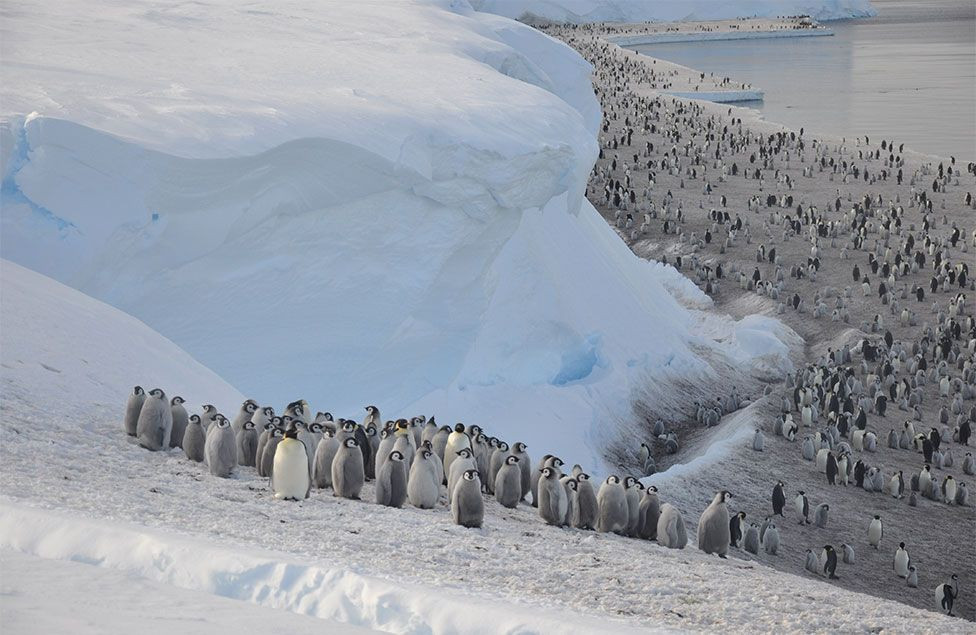An emperor penguin that was found on a remote Western Australian beach on Nov. 1 is now being cared for by a registered carer with the state’s Department of Biodiversity, Conservation and Attractions.
MELBOURNE, Australia (AP) — An emperor penguin found malnourished far from its Antarctic home on the Australian south coast is being cared for by a wildlife expert, a government department said Monday.
The adult male was found on Nov. 1 on a popular tourist beach in the town of Denmark in temperate southwest Australia — about 3,500 kilometers (2,200 miles) north of the icy waters off the Antarctic coast, according to a statement from the Western Australia state’s Department of Biodiversity, Conservation and Attractions.
The largest penguin species has never been reported in Australia before, University of Western Australia research fellow Belinda Cannell said, though some had reached New Zealand, Australia’s neighbor almost entirely south of Denmark.
Cannell said she had no idea why the penguin traveled to Denmark.
Cannell is advising seabird rehabilitator Carol Biddulph who is caring for the penguin, spraying him with a chilled water mist to help him cope with his alien climate. The penguin is 1 meter (39 inches ) tall and initially weighed 23 kilograms (51 pounds).
The department said its efforts were focused on rehabilitating the penguin. Asked if the penguin could potentially be returned to Antarctica, the department replied that “options are still being worked through.”
Why Did the Penguin Travel So Far?
Emperor penguins are renowned cold-weather specialists that can survive blustery winds and temperatures of around minus 40 degrees Fahrenheit during the Antarctic winter. So, what was one doing on a balmy beach in Australia last week?
Wildlife biologists are still scratching their heads after an emperor penguin showed up on Ocean Beach in Denmark, Western Australia, on November 1. The bird was about 2,100 miles from home—and much farther north than the species is typically found.
Aaron Fowler did a double take when he saw the out-of-place creature emerging from the waves on that Friday afternoon. He was out for a surf on Ocean Beach, which is located at the far southwestern tip of the continent.
“There was this big bird in the water, and we thought it was another sea bird, but then it kept coming closer to the shore—and it was way too big—and it just stood up and waddled right over to us,” he tells the Albany Advertiser’s Georgia Campion.
The penguin did not seem to be afraid of the humans on the beach. Fowler’s guess is that the bird “might have thought we were penguins because of our wet suits.”
“As he came out of the water he went to do a tummy slide, like I guess he’s used to on the ice, and he just did a kind of faceplant in the sand and shook all the sand off and looked a bit shocked,” Fowler adds to the Albany Advertiser. “It wasn’t until we got home and we googled it that we realized this never happens.”
To Fowler, the penguin looked “absolutely flawless,” as he tells the Australian Broadcasting Corporation’s Samantha Goerling, Jamie Thannoo and Peter Barr. But when wildlife biologists arrived at the beach, they found a juvenile male that was malnourished.
The penguin is now recovering under the watchful eye of registered wildlife caretaker Carol Biddulph, after she inspected the bird on the beach.
“The bird sort of turned at an angle, and I could see its backbone protruding, and I thought, ‘This bird is well undernourished,’ so that was a real consideration for bringing it in,” Biddulph says in a video shared with media outlets by Australia’s Department of Biodiversity, Conservation and Attractions (DBCA).
“Between the condition of the bird and the activity that might have happened on the beach the following day, I thought it was best to bring the bird in.”
Biddulph helped get the penguin into a large canvas pet carrier that was “nice and soft,” she says in the video. Then, she loaded the carrier into her car and drove the bird to her home. Biddulph has a dedicated penguin enclosure, but she’s “never had to deal with a large penguin like this before,” she adds. Usually, she cares for much smaller little penguins.
The first thing she did was encourage the penguin to step onto a scale so she could record its weight—about 50 pounds. This allowed her to understand how much medication and fluids to give the bird.
“Never in my wildest thoughts would I thought I’d ever have an emperor penguin to care for,” she says in the video. “It’s just amazing. It’s just such a privilege to be part of this bird’s journey.”
In a reference to the Roman emperor Augustus, the penguin has been named Gus.
Emperor penguins that have been equipped with tracking devices have never been recorded this far north, Belinda Cannell, a biologist at the University of Western Australia who is supporting the bird’s rehabilitation, says to the Australian Broadcasting Corporation.
Why was Gus so far from home? And how did he end up in Australia? No one knows for sure, but Cannell’s best guess is that the animal was searching for his next meal.
“What they tend to do is follow certain currents where they’re going to find lots of different types of food,” she tells the Australian Broadcasting Corporation. “So maybe those currents have just tended to be a little bit [farther] north towards Australia than they normally would.”
She adds: “Young penguins have to explore their world.”
Emperor Penguins and Climate Change
Emperors are the world’s largest penguin species, standing nearly four feet tall—roughly the same height as a 6-year-old human—and weighing around 88 pounds, according to the World Wildlife Fund.
The species is particularly vulnerable to changes brought on by global warming, including rising ocean temperatures and declining sea ice.
Other penguin species search for patches of bare ground in Antarctica on which to build their nests and raise their young every summer. But emperors lay their eggs and rear their chicks right on the ice during the winter. They rely on “land-fast” ice, a stable type of sea ice that is attached firmly to the shore. As the planet gets hotter, the amount of sea ice is shrinking; in some instances, it’s also breaking up and melting earlier in the spring than usual.
In 2022, more than 9,000 emperor penguin chicks likely died because their icy platform in Antarctica’s Bellingshausen Sea broke up early. Researchers described this as a “catastrophic breeding failure.”
A 2021 study predicted that 98 percent of emperor colonies would be quasi-extinct by 2100, unless the world cuts greenhouse gas emissions quickly.
Could the recent interloper’s appearance in Australia have something to do with climate change? Probably not, according to Cannell, who tells the Times there’s “no kind of rhyme or reason as to why” it ended up so far from home.
“Why it got this far, I’d love to know,” she adds.
Will Gus Be Able to Return to Antarctica?
Once the penguin has been nursed back to health, he will likely have to find his own way home. Transporting the bird would be too stressful for him, Cannell tells the London Times’ Bernard Lagan.
The department said its efforts were focused on rehabilitating the penguin. Asked if the penguin could potentially be returned to Antarctica, the department replied that “options are still being worked through.”
It is not clear how the juvenile male ended up so far north, but experts suggest he was motivated by his appetite
Wildlife officials are looking at options for the malnourished penguin's future and returning him home has not been ruled out.

















